
The province of Massa-Carrara is a province in the Tuscany region of Italy. It is named after the provincial capital Massa, and Carrara, the other main town in the province.
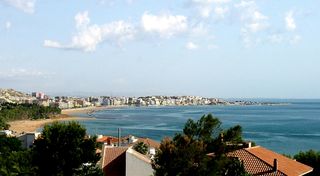
Crotone is a city and comune in Calabria, Italy.

Carrara is a town and comune in Tuscany, in central Italy, of the province of Massa and Carrara, and notable for the white or blue-grey marble quarried there. It is on the Carrione River, some 100 kilometres (62 mi) west-northwest of Florence. Its motto is Fortitudo mea in rota.

Carrara marble, Luna marble to the Romans, is a type of white or blue-grey marble popular for use in sculpture and building decor. It has been quarried since Roman times in the mountains just outside the city of Carrara in the province of Massa and Carrara in the Lunigiana, the northernmost tip of modern-day Tuscany, Italy.
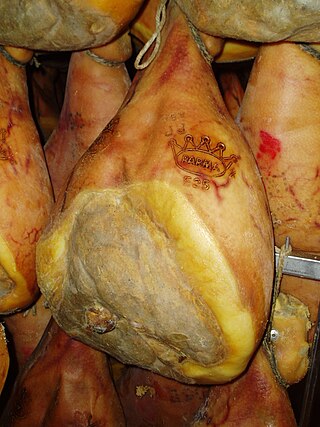
Prosciutto crudo, in English often shortened to prosciutto, is uncooked, unsmoked, and dry-cured ham. Prosciutto crudo is usually served thinly sliced.

Pancetta is a salt-cured pork belly meat product in a category known as salume. In Italy, it is often used to add depth to soups and pastas.

Empoli is a town and comune in the Metropolitan City of Florence, Tuscany, Italy, about 30 km southwest of Florence, to the south of the Arno in a plain formed by the river. The plain has been usable for agriculture since Roman times. The commune's territory becomes hilly as it departs from the river. Empoli is on the main railway line from Florence to Pisa, and is the point of divergence of a line to Siena. Empoli has an enduring tradition as an agricultural centre. It has given its name to a local variety of artichoke.

The Duchy of Massa and Principality of Carrara was a small state that controlled the towns of Massa and Carrara from 1473 until 1836.

Salo or slanina is a European food consisting of cured slabs of pork subcutaneous fat with or without skin and with or without layers of meat. It is commonly eaten and known under different names across Eastern and Southeastern Europe and is traditional to multiple national cuisines in the region. It is usually dry salt or brine cured. The East Slavic, Hungarian and Romanian variety is sometimes treated with paprika or other seasonings, whereas the South and West Slavic version is often smoked.

Vetulonia, formerly called Vetulonium, was an ancient town of Etruria, Italy, the site of which is probably occupied by the modern village of Vetulonia, which up to 1887 bore the name of Colonnata and Colonna di Buriano: the site is currently a frazione of the comune of Castiglione della Pescaia, with some 400 inhabitants.
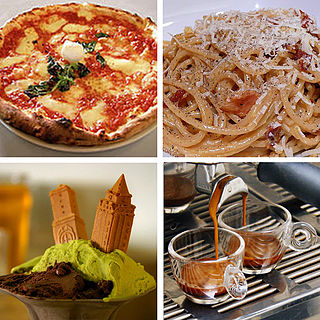
Italian cuisine is a Mediterranean cuisine consisting of the ingredients, recipes and cooking techniques developed in Italy since Roman times and later spread around the world together with waves of Italian diaspora. Some of these foods were imported from other cultures. Significant changes occurred with the colonization of the Americas and the introduction of potatoes, tomatoes, capsicums, maize and sugar beet—the latter introduced in quantity in the 18th century. It is one of the best-known and most appreciated gastronomies worldwide.

Sugo all'amatriciana or alla matriciana, also known as salsa all'amatriciana, is a traditional Italian pasta sauce based on guanciale, pecorino romano cheese, tomato, and, in some variations, onion. Originating from the town of Amatrice, the amatriciana is one of the best known pasta sauces in present-day Roman and Italian cuisine. The Italian government has named it a traditional agro-alimentary product of Lazio and amatriciana tradizionale is registered as a traditional speciality guaranteed in the EU and the UK.

Luni is a comune (municipality) in the province of La Spezia, in the easternmost end of the Liguria region of northern Italy. It was founded by the Romans as Luna. It gives its name to Lunigiana, a region spanning eastern Liguria and northern Tuscany.
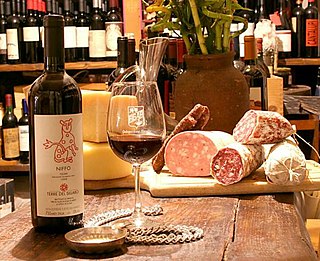
Salumi are Italian meat products typical of an antipasto, predominantly made from pork and cured. Salumi also include bresaola, which is made from beef, and some cooked products, such as mortadella and prosciutto.
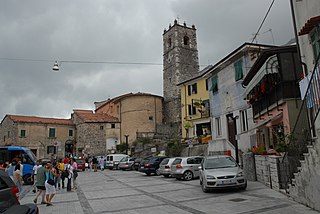
Colonnata is an Italian ancient village and a hamlet (frazione) of the comune of Carrara,. It is situated in the Apuan Alps, and is known worldwide for the pork fat delicacy Lardo di Colonnata, and for its marble quarries.

Cesena Football Club is an Italian football club based in Cesena, Emilia-Romagna. Currently it plays in Italy's Serie C. It has claimed to be the phoenix club of AC Cesena since 2018, the year that the club folded.

The Marmifera, full name Italian: Ferrovia Marmifera Privata di Carrara, lit. 'private marble railway of Carrara', was an Italian industrial railway used for the transport of Carrara marble from the quarries of the municipal territory of Carrara, Tuscany. The route extended from the hillside village of Colonnata to the port of Marina di Carrara.

The Avenza–Carrara railway was a short line connecting the center of Carrara with the locality of Avenza, falling in the same municipality, on which there was and still there is a station of the Genoa-Pisa railway. Opened in 1866, the line constituted later an element of the Carrara Private Marble railway; after the closure of the latter it remained in service as goods connection until the closure to traffic in 1969. The definitive suppression was established by Decree of the President of the Republic no. 1459 of December 28, 1970.
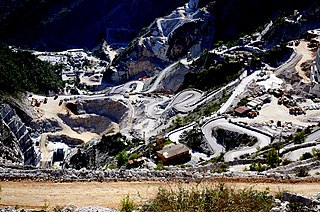
Miseglia is a village in Tuscany, central Italy, administratively a frazione of the comune of Carrara, province of Massa-Carrara. At the time of the 2011 census its population amounted to 449.
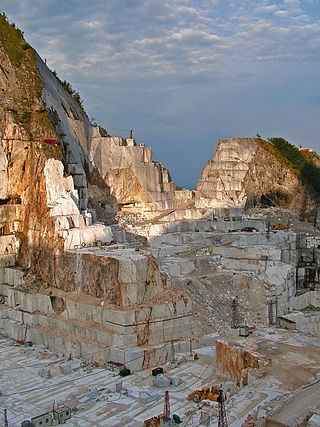
No Cav is an Italian protest movement that arose in the early 21st century, criticising the Carrara marble quarries in the Apuan Alps.























